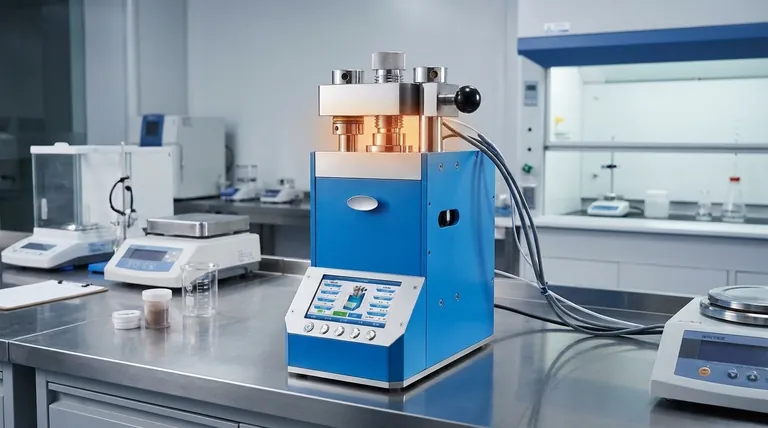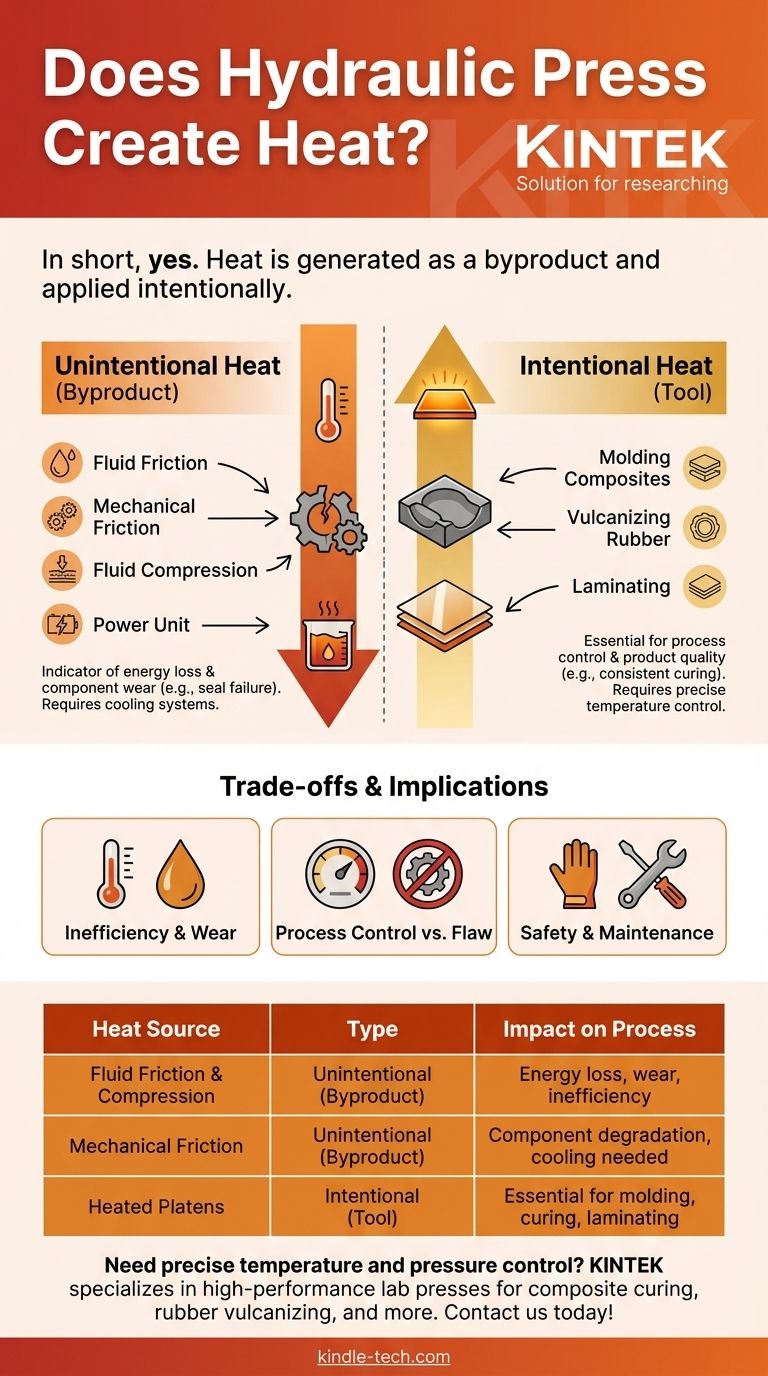In short, yes. A hydraulic press generates heat, but it is critical to distinguish between the two primary ways this happens. Heat is generated unintentionally as a natural byproduct of the machine's operation, and in many industrial processes, heat is also applied intentionally as a necessary part of the manufacturing task itself.
The core principle to understand is that while hydraulic systems create unwanted heat through friction and fluid compression, many of their most powerful applications depend on deliberately adding controlled heat via heated plates to mold, form, or cure materials.

The Two Sources of Heat in a Hydraulic System
To properly evaluate a hydraulic press, you must understand that heat can be either a wasteful byproduct or a fundamental tool. The source determines its impact on your operation.
Unintentional Heat: The Byproduct of Work
Any machine that converts energy and has moving parts will lose some of that energy as heat. This is a fundamental concept of thermodynamics.
In a hydraulic press, this waste heat comes from several places:
- Fluid Friction: As hydraulic oil is forced through hoses, valves, and fittings, friction between the fluid and the surfaces generates heat.
- Mechanical Friction: The movement of the piston against its seals and the cylinder walls creates friction and, consequently, heat.
- Fluid Compression: The act of pressurizing the hydraulic fluid itself causes its temperature to rise.
- The Power Unit: The electric motor or engine that drives the hydraulic pump is a significant source of waste heat.
Intentional Heat: A Tool for Manufacturing
For many modern industrial applications, pressure alone is not enough. Heat is deliberately introduced into the process using heated plates, known as platens.
These systems are common in industries that require shaping or chemical changes in materials. Examples include:
- Molding Composites: Curing thermoset plastics or composite materials like carbon fiber.
- Vulcanizing Rubber: Applying heat and pressure to strengthen rubber components.
- Laminating: Bonding layers of wood or plastic together to create panels and other elements.
In these cases, the heat is supplied by external sources, such as electric cartridge heaters embedded directly within the press platens.
Understanding the Trade-offs and Implications
Distinguishing between these two heat sources is essential for efficiency, safety, and product quality.
Inefficiency and Component Wear
Unintentional heat is a direct indicator of energy loss. The energy that is converted to heat is energy that is not being used to do work.
Excessive operational heat can degrade hydraulic oil, cause seals to fail prematurely, and reduce the overall lifespan of the machine. This is why large, continuously operating hydraulic systems are often equipped with heat exchangers or cooling radiators.
Process Control vs. Process Flaw
In applications that require applied heat, precise temperature control is just as critical as pressure control. Inconsistent temperatures can lead to improperly cured parts, weak bonds, and a high rate of product rejection.
Conversely, if a process is not supposed to involve heat, any significant temperature increase from the machine's operation can damage heat-sensitive materials or alter their properties in undesirable ways.
Safety and Maintenance
Both sources of heat create potential hazards. Hot surfaces from heated platens are an obvious burn risk.
Furthermore, a system running excessively hot due to inefficiency can signal underlying maintenance issues, such as worn components or improper fluid levels, which can lead to catastrophic failure if ignored.
Making the Right Choice for Your Goal
Your approach to heat management depends entirely on your specific application and objectives.
- If your primary focus is on simple pressing or forming: Treat any significant heat generation as a sign of inefficiency that needs to be managed to ensure the longevity and reliability of your equipment.
- If your primary focus is on molding, curing, or laminating: View heat as a critical, controllable input that must be precisely regulated to achieve consistent, high-quality results.
- If your primary focus is on safety and maintenance: Recognize that all hydraulic systems produce heat, requiring diligent monitoring and clear safety protocols to protect both personnel and the machine itself.
Ultimately, understanding whether heat is a byproduct to be minimized or a tool to be controlled is the key to using a hydraulic press effectively and safely.
Summary Table:
| Heat Source | Type | Impact on Process |
|---|---|---|
| Fluid Friction & Compression | Unintentional (Byproduct) | Indicates energy loss; can cause wear and inefficiency |
| Mechanical Friction | Unintentional (Byproduct) | Leads to component degradation; requires cooling systems |
| Heated Platens | Intentional (Tool) | Essential for molding composites, vulcanizing rubber, and laminating |
Need precise temperature and pressure control for your lab processes? KINTEK specializes in high-performance lab equipment, including hydraulic presses with advanced heating systems for applications like composite curing, rubber vulcanizing, and laminating. Let our experts help you select the right press to enhance efficiency, safety, and product quality. Contact us today to discuss your specific laboratory needs!
Visual Guide

Related Products
- Automatic Laboratory Hydraulic Press for XRF & KBR Pellet Press
- Laboratory Hydraulic Press Split Electric Lab Pellet Press
- Automatic High Temperature Heated Hydraulic Press Machine with Heated Plates for Lab
- Manual High Temperature Heated Hydraulic Press Machine with Heated Plates for Lab
- Laboratory Hydraulic Press Lab Pellet Press Machine for Glove Box
People Also Ask
- What are the disadvantages of KBr FTIR? Key Limitations That Impact Your Data Quality
- What is the use of manual hydraulic press? A Cost-Effective Tool for Lab Sample Preparation
- How do you prepare a KBr pellet for IR spectroscopy? Master the Key Steps for a Clear Spectrum
- How do you prepare soil for XRF sample? A Step-by-Step Guide to Accurate Analysis
- What is KBr disc method? A Complete Guide to IR Spectroscopy Sample Prep



















